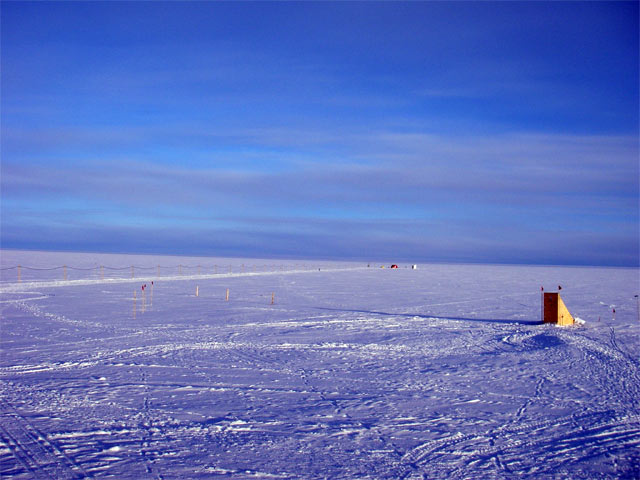( Log In ) Log In is for TREC Teachers & Researchers only
  |
| Kevin_McMahon |
 Jun 7 2006, 10:16 PM Jun 7 2006, 10:16 PM
Post
#1
|
 Advanced Member    Group: TREC Team Posts: 147 Joined: 12-April 06 Member No.: 25 |
High Temperature: -11 degrees Celsius
Low Temperature: -25 degrees Celsius Oompah Lumpah Land Looking off into the distance, I couldn’t believe my eyes. Could it be? No, it must be a mirage. Two tiny white creatures where moving blocks of snow. “I have been in the sunlight for too long,” I thought to myself. I rubbed my tired eyes and looked again. The image wouldn’t go away. I grabbed my parka and rushed outside. I quietly worked my way to the big hole they were digging. Blocks and blocks of snow were piled everywhere. Were these Greenlandic igloo builders? Were these the mythical Oompah Lumpahs from Charlie and the Chocolate Factory? “Kevin, where have you been?” shouted one of the Oompah Lumpahs. “How did it know my name?” I thought. “Kevin, I am serious, where have you been?” shouted the creature again. “Get a clean suit and join us”. “Join you?” I asked. “The clean suits are in the gray box”. “And bring a saw!” ordered the tallest Oompah Lumpah.  I shook my head. This wasn’t a dream. These were not Greenlandic igloo builders. These were not the mythical Oompah Lumpahs. These creatures were Mike and Gayle and they were digging a snow pit! I quickly learned our mission. We were to dig a three meter deep hole so that we could take snow samples at various depths. “Anyone can dig a three meter deep hole”, Mike explained. “The tricky part is being able to dig a three meter hole that you can walk out of!” I quickly learned that a saw was a valuable tool for our task. The saw cut through the snow like a knife cuts through butter. You could cut out a huge block of snow and then use your shovel to release the block from its frozen location. The snow blocks were quite light for their size.  When we dug to the bottom of our pit, Mike used wooden skewers to mark the depth of our pit. He put a skewer in at every 10 centimeters. To mark of 50 cm, 100 cm, 150 cm, 200 cm, and 250 cm spots, Mike inserted two wooden skewers.  Wow, that is a deep hole! Can you see the wooden skewers marking the different depths? One wall of the pit was going to be our sampling area. Mike inserted a wide-mouthed bottle into the top of our wall (where the snow pit was between zero meters deep and ten centimeters deep). When he pulled out the bottle, it looked like a jar full of snow crystals. He did this with 9 more big bottles on top of our wall and then with four smaller bottles. After taking samples from the first 10 centimeter layer, Mike proceeded to scrape away loose snow and then sample the next 10 centimeter layer in a similar fashion.  Mike carefully taking a snow sample We worked hard today. It took us 12 hours from when we began digging until we were done sampling. We got really lucky with the weather. It warmed up to -11 degrees Celsius. It did not seem cold until the last five layers. By then, holding the cold glass bottles while wearing only glove liners and a plastic glove was tough because your fingers would quickly get numb. I had to take several breaks and stick my hands into a pair of mittens to get my fingers warm again. What happens with all these bottles of snow? We take them back to our science lab (the red building below) and let them melt. Then, we let the water from these bottles flow through a filter to trap any particles that are found in the snow. When we filter the melted snow, we are actually able to see small dark specks in the snow.  Our science lab is in the red weatherport about 1/2 mile from the Big House Gayle will take each filter and put it in a protective case. She will bring these particles back to Georgia Tech and test them further. The instruments at Georgia Tech will be able to tell us if these particles came from burning coal or from the burning of other materials. Well, I bet you want to see an embarrassing picture of your teacher in a clean suit. I won’t disappoint you.  Arctic Fact of the Day: An ice sheet is a dome-shaped glacier that covers an area greater than 19,300 square miles (50,000 square kilometers). Summit camp is located on an ice sheet. An icecap is a dome-shaped glacier that covers an area of 19,300 square miles (50,000 square kilometers) or less. |
  |
2 User(s) are reading this topic (2 Guests and 0 Anonymous Users)
0 Members:

|
NSF Acknowledgment & Disclaimer | Time is now: 30th October 2024 - 01:31 PM |
Invision Power Board
v2.1.7 © 2024 IPS, Inc.








